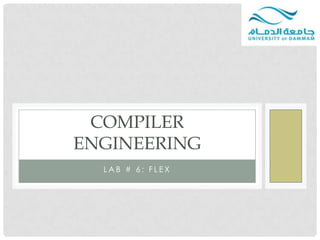
6 compiler lab - Flex
- 1. COMPILER ENGINEERING LAB # 6: FLEX
- 2. REVISION: FLEX • A flex program consists of three sections, separated by %% lines, which are: 1. Definition Section: contains declarations and option settings • Any code inside of %{ and %} is copied through verbatim near the beginning of the generated C source file 2. Rules Section: is a list of patterns and actions. • Each pattern must start at the beginning of the line, since flex considers any line that starts with whitespace to be code to be copied into the generated C program. Department of Computer Science - 7-11/4/12 2 Compiler Engineering Lab
- 3. REVISION: FLEX • A flex program consists of three sections, separated by %% lines, which are: 3. Sub-routines Section: is C code that is copied to the generated scanner, usually small routines related to the code in the actions. • The C code at the end is a main program that calls yylex(), the name that flex gives to the scanner routine, and then prints the results • Note: • In the absence of any other arrangements, the scanner reads from the standard input Department of Computer Science - 7-11/4/12 3 Compiler Engineering Lab
- 4. REVISION: FLEX • yytext is set to point to the input text that the pattern just matched. • Each Token Flex returns has two parts: 1. The Token (The Token Zero always means End-of-File) 2. The Token Value Department of Computer Science - 7-11/4/12 4 Compiler Engineering Lab
- 5. REGULAR EXPRESSIONS Regular Meaning Expression Symbol + Match one or more of the preceding patterns * Match Zero or more of the preceding patterns | Or . Any character except new line n New line [] Character Class - Range ^ Not (Negative), ^ at the beginning of the character class means to match any character other than the ones in the class Department of Computer Science - 7-11/4/12 5 Compiler Engineering Lab
- 6. REVISION: FLEX • Ex: for the input (3+44+100) which regular expression will be used? digit [0-9] %% “+” {printf (“Plusn”);} [a-zA-Z] {printf (“IDn”);} digit+ {printf (“Plusn”);} ([0-9]digit) {printf (“Plusn”);} %% • What happens If Flex matches two patterns: • It will take the longer match (number of characters) • If both were equal in length, it will take the first match to appear. Department of Computer Science - 7-11/4/12 6 Compiler Engineering Lab
- 7. USING FLEX TOOL 1. $ flex WordCount.l • First we tell flex to translate our program, and in classic Unix fashion since there are no errors, it does so and says nothing. 2. $ cc lex.yy.c –lfl • Then we compile lex.yy.c, the C program it generated; link it with the flex library, -lfl 3. $ ./a.out This is an example for compiler lab • run it; and type a little input for it to count (to stop input to file press Ctrl + D [or type End-of-File character: ^D on Unix, ot ^Z on Windows]). Department of Computer Science - 7-11/4/12 7 Compiler Engineering Lab
- 8. FLEX FILE EXAMPLE # 1: CALCULATOR • Write a Calculator .l scanner, returning token for following lexemes: • Plus + • Minus – • Multiplication * • division / • Absolute| • Number types and values • End of line • White space • Any other character print an error message Department of Computer Science - 7-11/4/12 8 Compiler Engineering Lab
- 9. * recognize tokens for the calculator and print them out */ Cal.l %% “+” { printf("PLUSn"); } “-” { printf("MINUSn"); } “*” { printf("TIMESn"); } “/” { printf("DIVIDEn"); } “|” { printf("ABSn"); } [0-9]+ { printf("NUMBER %sn", yytext); } n { printf("NEWLINEn"); } [ t] { } { printf("Mystery character %sn", yytext); } %% Department of Computer Science - 7-11/4/12 9 Compiler Engineering Lab
- 10. FLEX FILE EXAMPLE # 2: CALCULATOR • Adjust the Calculator.l scanner written in the previous example (#1), where the scanner will return the value of the tokens instead of printing them: • NUMBER = 258, ADD = 259, SUB = 260, MUL = 261, DIV = 262, ABS = 263, EOL = 264 end of line Department of Computer Science - 7-11/4/12 10 Compiler Engineering Lab
- 11. /* recognize tokens for the calculator and print them out */ Cal2.l %{ enum yytokentype { NUMBER = 258, ADD = 259, SUB = 260, MUL = 261, DIV = 262, ABS = 263, EOL = 264}; int yylval; %} %% ”+” { return ADD; } ”-” { return SUB; } ”*” { return MUL; } ”/” { return DIV; } ”|” { return ABS; } [0-9]+ { yylval = atoi(yytext); return NUMBER; } n { return EOL; } [ t] { /* ignore whitespace */ } . { printf("Mystery character %cn", *yytext); } %% main(int argc, char **argv) { int tok; while(tok = yylex()) { printf("%d", tok); if(tok == NUMBER) printf(" = %dn", yylval); else printf("n"); }} Department of Computer Science - 7-11/4/12 11 Compiler Engineering Lab
- 12. FLEX FILE EXAMPLE # 3: WORD COUNTER • Write a Flex file that is capable to produce a scanner that counts: • Characters, • New lines, • And words Department of Computer Science - 7-11/4/12 12 Compiler Engineering Lab
- 13. WordCount.l /* just like Unix wc */ %{ int chars = 0; int words = 0; int lines = 0; %} %% [a-zA-Z]+ { words++; chars += strlen(yytext); } n { chars++; lines++; } . { chars++; } %% main(int argc, char **argv) { yylex(); printf("%8d%8d%8dn", lines, words, chars); } Department of Computer Science - 7-11/4/12 13 Compiler Engineering Lab
- 14. QUESTIONS? Thank you for listening Department of Computer Science - 7-11/4/12 14 Compiler Engineering Lab